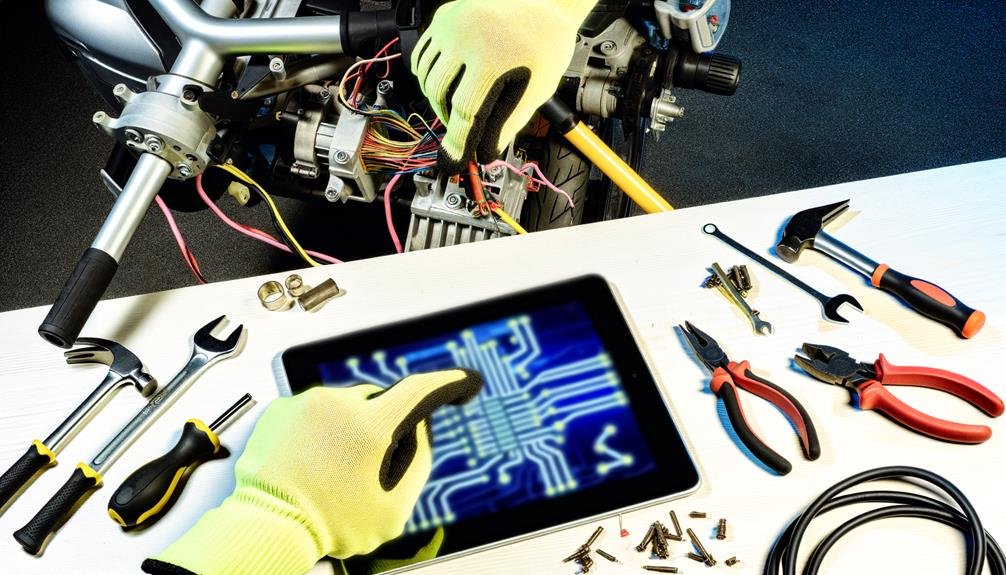Charles Miller is a veteran bike enthusiast with over 12 years of experience dealing with bikes as a mechanic. Despite immense love and expertise for...
They say necessity is the mother of invention, and today, we're seeing this timeless adage come to life in the form of ebike conversions.
Many of us have bikes gathering dust in our garages, and we're beginning to wonder whether they could be transformed into something more. Can we breathe new life into these old two-wheelers by converting them into electric bikes?
What would the process entail, how cost-effective would it be, and what potential challenges might we encounter?
Let's explore these questions together, as we embark on this fascinating journey of innovation.
- Key Takeaways
- Understanding E-Bike Conversion
- Choosing Your Conversion Kit
- Steps to Convert Your Bike
- Cost of E-Bike Conversion
- Pros and Cons of Conversion
- Types of E-Bike Conversion Kits
- Best E-Bike Conversion Kits
- Safety Measures for Conversion
- Legal Aspects of E-Bikes
- Maintenance of Your New E-Bike
- Frequently Asked Questions
- Conclusion
Key Takeaways
- E-bike conversions offer a range of benefits, including a power boost and easier cycling, cost-effectiveness compared to buying a new bike, and the ability to explore more roads and ride with others.
- Important considerations for e-bike conversion include compatibility with bike measurements, budget and battery wattage considerations, and researching and comparing different kit options.
- The process of choosing and installing a conversion kit involves checking compatibility, balancing budget and needs evaluation, swapping the tire and tube, attaching various components, wiring everything up, and making adjustments for optimal performance.
- Safety, legal aspects, and maintenance are essential considerations when converting a bike into an e-bike, including selecting and using protective gear, understanding legal requirements and compliance, and performing regular maintenance on the converted e-bike.
Understanding E-Bike Conversion
Diving into the realm of e-bike conversions, it's crucial to comprehend the manifold benefits, important considerations, and diverse kit options available to effectively transform your traditional bicycle into an efficient electric bike.
We enjoy the added power an electric bike conversion kit offers without having to buy a whole new bike. This allows us to replace our cars for errands, extending our ride range, and enhancing fitness by enabling us to ride with a greater range of people.
When we opt to convert a bike, we must ensure compatibility with our bike's measurements, factor in our budget, motor location preference, and battery type. We also need to choose the battery wattage that suits our needs, and research different kits to find the best fit. For instance, Swytch eBike Conversion Kit, TongSheng TSDZ2 Mid Drive Motor, and Voilamart 48V Rear Wheel Kit are just a few of the numerous options available.
Further, we need to be aware of certain considerations and limitations, including regenerative braking, laws, and our mechanical competence. We must also remember that not all kits include a battery, so we need to check before purchasing.
Choosing Your Conversion Kit
After understanding the broader aspects of e-bike conversion, we now need to focus on the critical task of choosing the right conversion kit for our bicycle. Selecting the appropriate e-bike conversion kits requires careful thought and a detailed approach.
Here are four crucial steps to guide us in choosing your conversion kit:
- Compatibility Check: We must ensure the conversion kit is a perfect fit for our bike. This process involves measuring the frame, forks, rear stays, wheel size, and brakes.
- Budget vs Needs Evaluation: We've to balance our budget with our needs. This step helps us determine the amount we're willing to spend and the type of battery and wattage rating that suits our requirements.
- Research and Comparison: We need to dig deep, research, and compare different kits. Factors to consider include motor location and specific bike compatibility.
- Consider Kit Details: Specific kit details such as motor position, battery capacity, and installation method are important. We should base these on our bike's frame and our mechanical abilities.
Steps to Convert Your Bike

We're now moving on to the essential steps necessary to convert your bike into an ebike.
This involves not just choosing the right conversion kit suitable to your needs and bike type, but also understanding the installation process in a simplified manner.
We'll be providing a detailed, analytical guide on each step involved, ensuring clarity and precision in your conversion journey.
Choosing the Right Kit
To choose the optimal kit for converting your bike into an eBike, it's essential to accurately measure your bike's frame, forks, rear stays, wheel size, and brakes to ensure compatibility with the proposed conversion kit.
When choosing the right kit, consider these key steps:
- Determine your budget and needs. This will guide your selection of motor location, battery type, and wattage rating.
- Research and compare different electric bike conversion kits. This can help you find the best e-bike conversion option suitable for your bike and requirements.
- Choose from conversion kit options like Swytch eBike, TongSheng TSDZ2 Mid Drive Motor, or Voilamart 48V Rear Wheel Kit.
- Follow the step-by-step conversion process diligently. This includes swapping the tire and tube, attaching the bracket, magnet disc, sensor, and wiring everything up.
Doing so ensures you embark on a successful e-bike conversion journey, belonging to the growing community of e-bike enthusiasts.
Installation Process Simplified
Having chosen the right kit for our bike, let's now focus on the step-by-step installation process to convert your traditional bike into an efficient eBike.
First, we need to swap the tire and tube of the wheel provided with the conversion kit.
Next, we attach the bracket to the electric motor and connect it to the bike frame.
The magnet disc and sensor are then installed, which are crucial for the motor operation.
The installation process simplified, we proceed to wire everything up, connecting the motor, controller, and battery.
Finally, adjustments and tuning are done to ensure optimal performance.
Remember, the conversion process might require some mechanical skills and understanding of electric bike laws.
With this, our bike conversion is complete.
Cost of E-Bike Conversion
Diving into the financial aspects of e-bike conversion, you'll find that the cost of a typical conversion kit ranges anywhere from $250 to $750, with variations based on brand, motor power, and battery options. It's essential to understand that these costs are influenced by the complexity of the e-bike conversion kit and the quality of the components included.
To help you budget, here are four key cost factors to consider:
- Cost of the e-bike conversion kit: As we've noted, this ranges between $250 and $750. It's a significant part of the overall cost, so choose wisely.
- Battery costs: Not all kits include a battery. If it's not included, factor in an additional $200-$400.
- Installation costs: If you're not a DIY enthusiast, professional installation will add to your total. Expect to pay between $50 and $200.
- Value comparison: Consider the cost of converting your current bike versus buying a new electric one. Weigh the benefits, such as customized motor power and range.
Pros and Cons of Conversion

Evaluating the pros and cons of converting a regular bike into an e-bike is a critical step in the decision-making process. Let's delve into some of the pros and cons of conversion.
Starting with the pros, converting your normal bike to an electric one provides an additional power boost, making cycling easier and more enjoyable. It's a cost-effective alternative to buying a full electric bike, and it allows us to explore more roads and ride with a larger group of people. Additionally, detailed, step-by-step guides are available to make the conversion process easier.
However, there are also some cons to consider. The conversion may void your bike's warranty. The process requires careful consideration of compatibility and measurements to ensure a proper fit. It can be time-consuming, especially when converting the bottom bracket. Additionally, electric bike laws and regulations must be taken into account as they can limit the range and speed of your converted bike.
Types of E-Bike Conversion Kits
After weighing the pros and cons of converting a regular bike into an e-bike, let's now explore the different types of e-bike conversion kits available in the market. This will help you make an informed decision about your electric bike conversion.
- Hub Motor Kits: These are quite popular due to their compatibility with various bike types and ease of installation. The motor is housed in the hub of the wheel.
- Mid-Drive Motor Kits: A step up from the hub motor, the mid-drive conversion places the motor onto the bike's bottom bracket. This provides better weight distribution and performance, especially on challenging terrains.
- Friction Drive Kits: These kits use a roller in direct contact with the bike's tire to propel it. This makes them a versatile and simple conversion option.
- All-in-One Kits: These comprehensive kits include everything: the motor, battery, wiring, and controls. They're an ideal choice for those who wish for a complete, all-encompassing solution.
Best E-Bike Conversion Kits

Let's delve into the realm of the best e-bike conversion kits, examining their technical specifications, unique features, and applicability to different types of bicycles.
For the best electric bike conversion, the Swytch kit is a top contender. Its portable design makes it compatible with most bikes, providing a seamless transition from a regular bike to electric.
For those preferring a mid-drive system, the TongSheng TSDZ2 is an excellent choice. It's renowned for its torque-sensing ability, giving a more natural cycling feel.
If you're on a budget, the Voilamart 48V Rear Wheel kit offers a high-speed motor with easy installation.
The Rubbee X stands out with its friction drive mechanism and compact design, while the Bafang front hub motor kit impresses with its powerful performance and ease of installation.
The Voilamart 48V rear wheel kit provides the perfect balance of speed and distance coverage, appealing to long-distance cyclists.
It's essential to consider factors like compatibility, budget, and motor location when choosing a kit. Remember, the ultimate goal is to enhance your cycling experience, not complicate it.
With research and careful selection, it's easy to find the right kit for your needs. Happy converting!
Safety Measures for Conversion
As we transition into the next stage of our e-bike conversion, we must prioritize safety measures.
This includes:
- The selection and use of essential protective gear
- The application of correct conversion techniques
- The execution of comprehensive post-conversion safety checks
Being meticulous in these areas will ensure both the longevity of your e-bike and your personal safety.
Essential Protective Gear
Before starting the conversion process of turning your bike into an ebike, it's crucial to equip ourselves with the necessary protective gear to ensure safety.
As part of this cycling transformation, we've identified four essential items:
- A well-fitted helmet: Protects your head from potential impacts during the electric kit installation.
- Safety goggles or glasses: Shields your eyes from debris while handling tools.
- Durable gloves: Offers protection from cuts, scrapes, and potential electrical hazards during the conversion.
- Sturdy closed-toe footwear: Safeguards your feet from accidental injuries.
Correct Conversion Techniques
To ensure a successful and safe conversion of your bike into an e-bike, it's essential to first confirm that the electric bike conversion kit is fully compatible with your bike's frame, forks, rear stays, wheel size, and brakes by taking precise measurements and cross-referencing them with the kit's specifications. This is the first step in a safe motor conversion.
| Steps for Conversion Safety | Details |
|---|---|
| Measure Accurately | Compatibility with the bike's frame and parts is key |
| Prioritize Safety | Ensure components are securely fitted and aligned |
| Know Local Laws | Familiarize yourself with e-bike laws and regulations |
| Check Wiring | Ensure electrical components are well-insulated |
Next, we'll install the pedal assist and other components from our kits. Remember, if you're unsure, professional guidance can ensure your conversion's success and safety.
Post-Conversion Safety Checks
Once we've successfully converted our bike to an e-bike, it's crucial that we conduct thorough post-conversion safety checks to ensure optimal and safe performance. We can't stress enough the importance of this step, which allows us to be confident in the safety and reliability of our newly converted e-bike.
- Inspect all electrical connections and wiring: This is to prevent short circuits or electrical hazards.
- Check the braking system: With the increased speeds and weight of the e-bike, our brakes must be up to par.
- Confirm the structural integrity of the bike frame: The additional stress and weight of the conversion kit must be accommodated.
- Test the motor and battery: This includes a trial run to ensure they're functioning properly and safely.
Legal Aspects of E-Bikes
It's crucial that we consider the legal aspects of e-bikes, which include local regulations, power limits, pedal-assist requirements, safety standards, and potential registration or licensing requirements. These factors ensure that your new e-bike equipped with a Mid-Drive Motor doesn't violate any laws and operates within safe parameters.
Before embarking on your bike conversion journey, it is essential to familiarize yourself with local e-bike laws. Different regions have distinct regulations regarding power limits, pedal-assist utilization, and safety standards. Therefore, understanding these legal aspects of e-bikes is paramount to avoid any legal issues post-conversion.
Here's a comprehensive table to highlight some of these considerations:
| Consideration | Description | Compliance Needed |
|---|---|---|
| Local Regulations | Laws governing e-bikes | Yes |
| Power Limits | Maximum power output | Yes |
| Pedal-Assist | Use of pedal-assist systems | Yes |
| Safety Standards | E-bike safety regulations | Yes |
Also, some regions require e-bikes to be registered or licensed. Ensure you comply to fully enjoy the benefits of your new e-bike without any legal hindrances.
Maintenance of Your New E-Bike

Having navigated the legal landscape of turning your traditional bike into an e-bike, let's now focus our attention on the maintenance aspect to ensure your new e-bike performs optimally and lasts longer. The maintenance of your new e-bike involves several key steps to preserve its functionality.
- Regular Cleaning: Ensure to clean your e-bike frequently, especially the mid-drive kit (motor, battery, and other components). Dirt and grime can cause damage and hinder optimal performance.
- Bolt Check: Bolts need constant inspection. Those securing the motor, battery, and electrical components must be tightly fastened to maintain stability and safety during rides.
- Brake Inspection: Regularly inspect brake pads, cables, and disc rotors. This ensures efficient and safe braking, a vital aspect of your e-bike's performance.
- Tire Maintenance: Regularly check the tire pressure, tread, and overall condition. This maintains traction, stability, and a smooth ride.
Frequently Asked Questions
Can You Turn a Regular Bike Into an Electric Bike?
Yes, we can convert a regular bike into an electric one. We'd follow a detailed conversion process, carefully select the right battery, and adhere to legal considerations. It's a doable, exciting project for us.
How Much Does It Cost to Convert a Bicycle to Electric?
We've analyzed conversion kits pricing and DIY conversion expenses. Costs range from $250 to $750. Factor in battery quality and pro installation fees. Do a cost benefit analysis against purchasing a pre-built ebike.
Is It Worth Converting a Bike to Electric?
We're often asked if it's worth converting a bike to electric. Considering the conversion benefits, drawbacks, and efficiency, we'd say it largely depends on your needs. It can certainly make cycling more accessible and enjoyable.
Can I Convert My Cycle to Electric?
Yes, we can convert our cycle to electric using conversion kits. It's essential to consider battery life and legal considerations. We'll need to ensure it's compatible with our bike and fits within our budget.
Conclusion
In wrapping up, converting our trusty steeds into ebikes is no uphill ride. It's an affordable alternative to buying a new ebike, broadening our horizons and giving our fitness a nudge.
It requires a little elbow grease and some technical know-how, but with the right kit, we're good to go. Just remember to keep safety first and stay on the right side of the law.
With proper care, our new ebike will be a trusty companion on many adventures!

Charles Miller is a veteran bike enthusiast with over 12 years of experience dealing with bikes as a mechanic. Despite immense love and expertise for his Tacoma, he rides his Trek Ebike more. Anytime you meet him, you’ll either hear him talking about Bikes, or writing about all things bikes and cars on this blog.
More Posts


